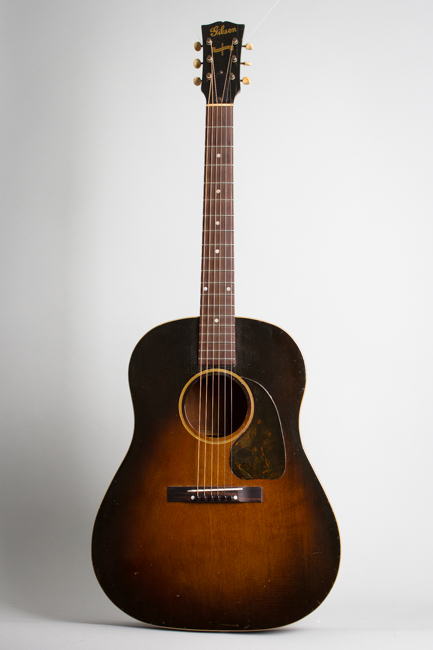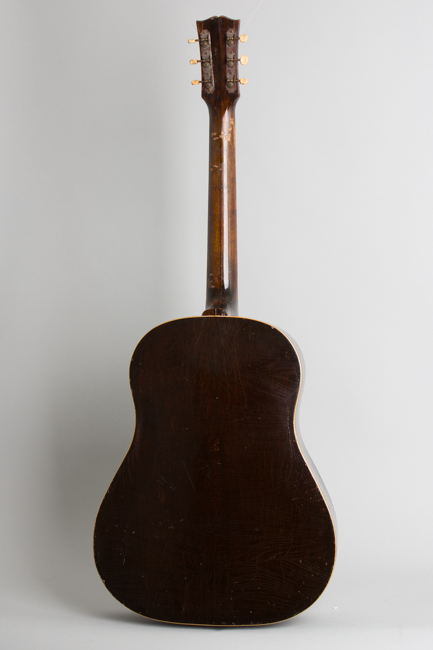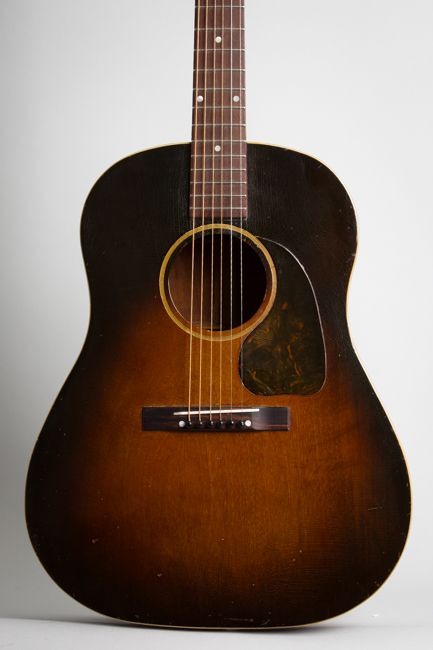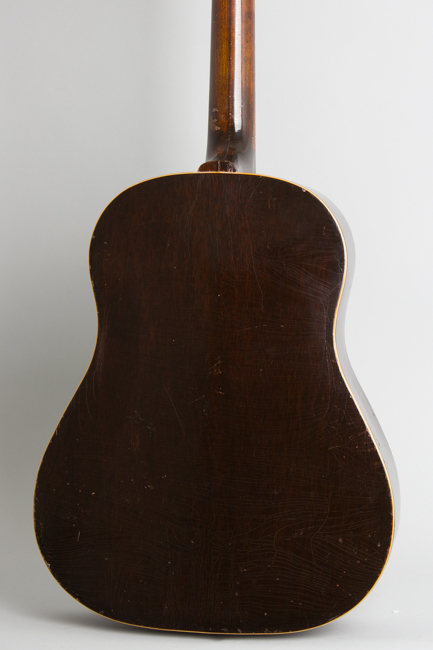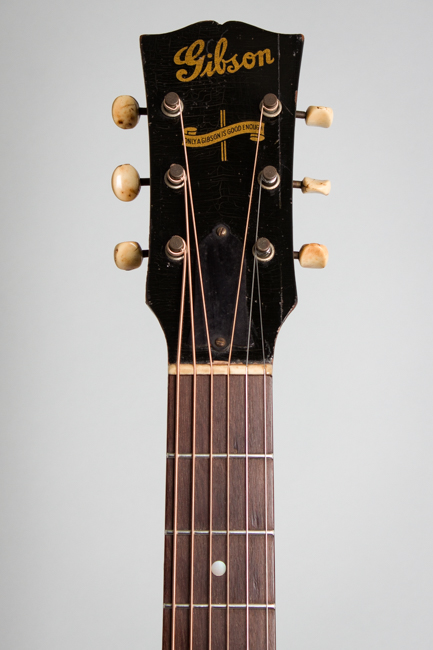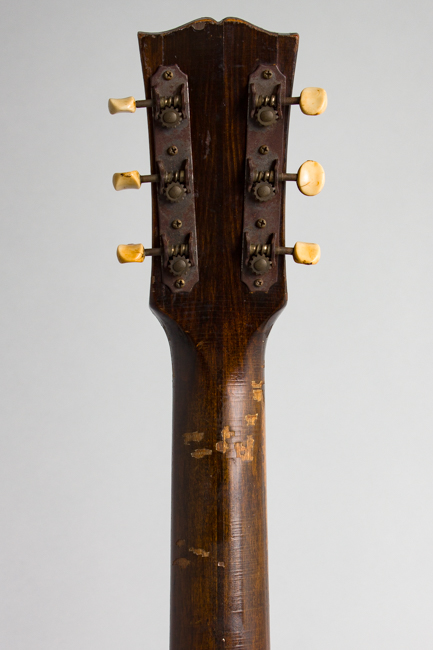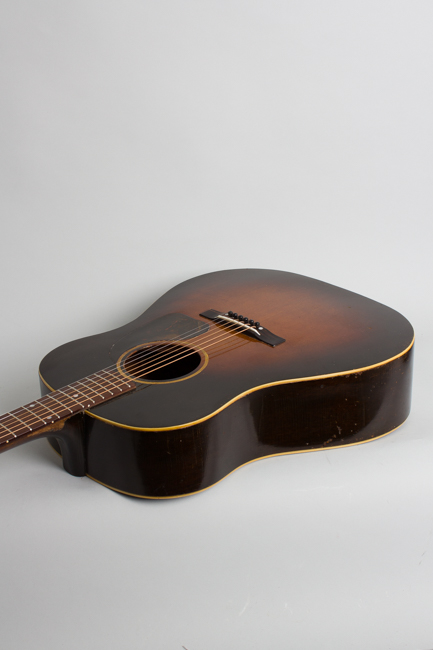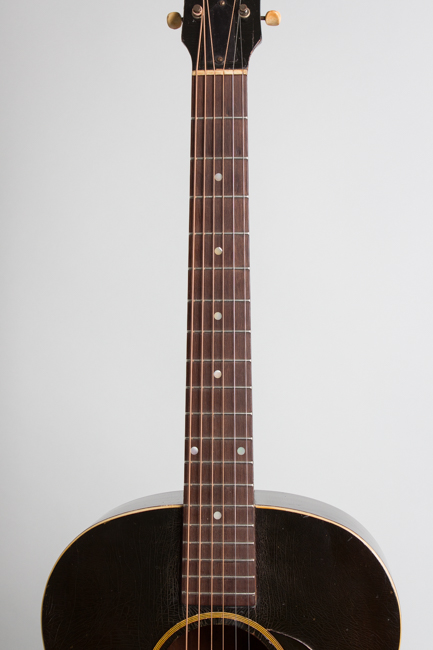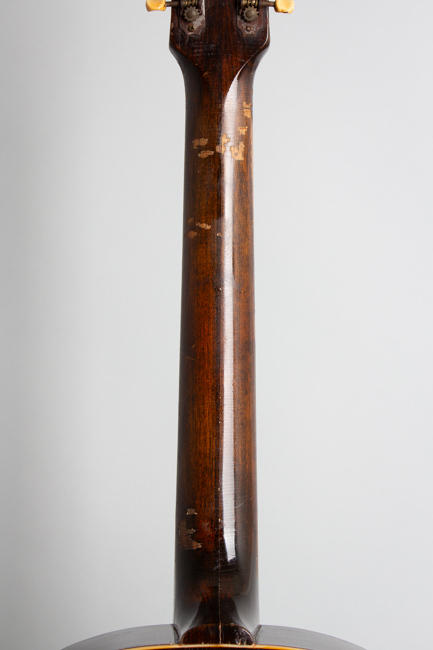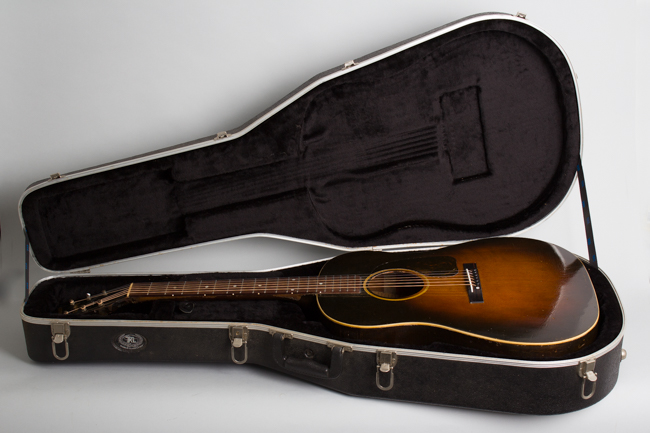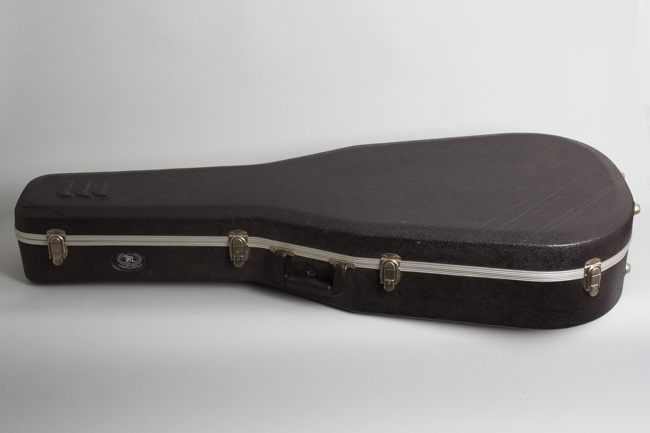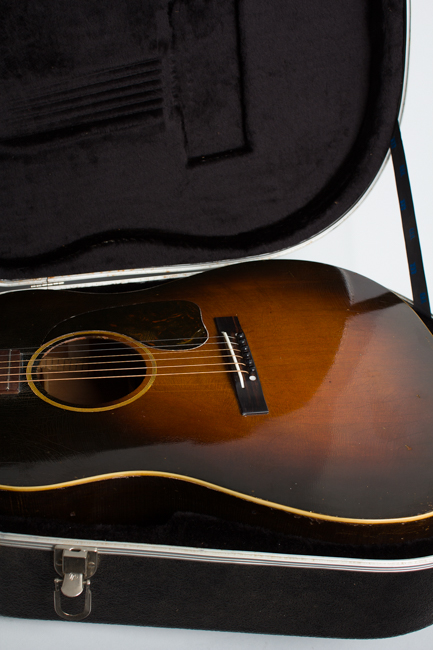Gibson J-45 Banner Flat Top Acoustic Guitar (1943)
This item has been sold.
Item # 11815
Prices subject to change without notice.
Gibson J-45 Banner Model Flat Top Acoustic Guitar (1943), made in Kalamazoo, Michigan, serial # 2681-24 (FON), sunburst top, dark back and sides finish, mahogany back, sides and top; laminated maple neck, molded plastic hard shell case.
This is a cool played-in veteran example of a "Banner" Gibson J-45 -- so called for the decal on the headstock reading "Only a Gibson Is Good Enough" used only during WWII. The J-45 was one of the few Gibson models in full production during the Second World War when the company's output was severely limited. In this period the specifications of individual instruments often vary greatly from published standards; Gibson ran short of many materials and struggled under wartime restrictions.
The widely variant features of these guitars were dictated by the materials available; this particular guitar has the unusual combination of a mahogany back and sides with a sunburst-finished mahogany top (instead of the normal spruce) and a 3-piece laminated maple neck. These latter two give the guitar a noticeable different feel and sound from the "standard" J-45.
This guitar is also somewhat unusual in retaining the standard adjustable truss rod, a feature often deleted from wartime models as metal was then severely rationed. The tuners are the slim flat-plate riveted Klusons of the period, specifically designed to use the minimum of metal possible. The top and back are single bound with a 7-ply soundhole ring and tortoise Celluloid pickguard. The Factory Order Number (FON) 2681-24 on the heelblock identifies this guitar as a 1943 (or possibly 1944) model, based on recent research. This is the second guitar from this batch we have had recently!
The neck profile is round and chunky, quite thick as are many wartime Gibsons despite the truss rod being installed. The individual features are typical of other guitars built in this period, but the specific combination of a mahogany top, maple neck AND the adjustable truss rod is a fairly rare find. This is a great-sounding guitar with a huge tone despite, or more likely because of, its unusual combination of woods. This particular "Banner" is in better condition than many of these structurally; cosmetically it is well-used but still a superb performer, an excellent players' example of this unusual J-45 variant.
Overall length is 41 in. (104.1 cm.), 16 1/8 in. (41 cm.) wide at lower bout, and 4 15/16 in. (12.5 cm.) in depth at side, taken at the end block. Scale length is 24 3/4 in. (629 mm.). Width of nut is 1 3/4 in. (44 mm.).
This guitar is somewhat worn but in excellent playing condition, recently emerged from a 100,000 mile checkup. The finish is nearly all original showing a checking to various degrees and general wear overall. The lacquer has some areas of fairly bold checking, especially on the back of the neck where there are some noticeable chipped-off spots including areas flaked off either side of the fingerboard. There are small dings, scrapes and dents everywhere but no really large areas worn away apart from the neck surface. The top is unusually free of the common pick marks and scrapes, showing only a rather randomly distributed collection of dings, chips and dents. The sides of the body show the deepest dings and scrapes.
Amazingly enough for a well-worn 80-year-old Gibson there is only one small crack, a repaired split between the treble side of the fingerboard and soundhole rim, solidly sealed up. The treble side wing of the headstock has been neatly reglued, the upper back corner of the bass side wing reglued as well. Internally there is some visible old (fairly sloppy0 brace re-gluing but all braces remain original, and are completely solid now.
The neck has been neatly reset with minimal touchup and the bridge is a modern repro with some attendant finish disturbance, mostly along the front edge from the original failing long ago. The original small maple bridgeplate is intact beneath showing the old holes from the now-deleted mounting bolts once under the bridge pearl dots. The fingerboard has been neatly refretted with period correct wire. The wartime tuners are still intact and working, with the original buttons slightly shrunken but fully solid and some corrosion to the metal. The guitar has seen some adventures since its origin 80 years ago during the war years but not abused, remaining a fine player with a very powerful sound. Very Good + Condition.
This is a cool played-in veteran example of a "Banner" Gibson J-45 -- so called for the decal on the headstock reading "Only a Gibson Is Good Enough" used only during WWII. The J-45 was one of the few Gibson models in full production during the Second World War when the company's output was severely limited. In this period the specifications of individual instruments often vary greatly from published standards; Gibson ran short of many materials and struggled under wartime restrictions.
The widely variant features of these guitars were dictated by the materials available; this particular guitar has the unusual combination of a mahogany back and sides with a sunburst-finished mahogany top (instead of the normal spruce) and a 3-piece laminated maple neck. These latter two give the guitar a noticeable different feel and sound from the "standard" J-45.
This guitar is also somewhat unusual in retaining the standard adjustable truss rod, a feature often deleted from wartime models as metal was then severely rationed. The tuners are the slim flat-plate riveted Klusons of the period, specifically designed to use the minimum of metal possible. The top and back are single bound with a 7-ply soundhole ring and tortoise Celluloid pickguard. The Factory Order Number (FON) 2681-24 on the heelblock identifies this guitar as a 1943 (or possibly 1944) model, based on recent research. This is the second guitar from this batch we have had recently!
The neck profile is round and chunky, quite thick as are many wartime Gibsons despite the truss rod being installed. The individual features are typical of other guitars built in this period, but the specific combination of a mahogany top, maple neck AND the adjustable truss rod is a fairly rare find. This is a great-sounding guitar with a huge tone despite, or more likely because of, its unusual combination of woods. This particular "Banner" is in better condition than many of these structurally; cosmetically it is well-used but still a superb performer, an excellent players' example of this unusual J-45 variant.
Overall length is 41 in. (104.1 cm.), 16 1/8 in. (41 cm.) wide at lower bout, and 4 15/16 in. (12.5 cm.) in depth at side, taken at the end block. Scale length is 24 3/4 in. (629 mm.). Width of nut is 1 3/4 in. (44 mm.).
This guitar is somewhat worn but in excellent playing condition, recently emerged from a 100,000 mile checkup. The finish is nearly all original showing a checking to various degrees and general wear overall. The lacquer has some areas of fairly bold checking, especially on the back of the neck where there are some noticeable chipped-off spots including areas flaked off either side of the fingerboard. There are small dings, scrapes and dents everywhere but no really large areas worn away apart from the neck surface. The top is unusually free of the common pick marks and scrapes, showing only a rather randomly distributed collection of dings, chips and dents. The sides of the body show the deepest dings and scrapes.
Amazingly enough for a well-worn 80-year-old Gibson there is only one small crack, a repaired split between the treble side of the fingerboard and soundhole rim, solidly sealed up. The treble side wing of the headstock has been neatly reglued, the upper back corner of the bass side wing reglued as well. Internally there is some visible old (fairly sloppy0 brace re-gluing but all braces remain original, and are completely solid now.
The neck has been neatly reset with minimal touchup and the bridge is a modern repro with some attendant finish disturbance, mostly along the front edge from the original failing long ago. The original small maple bridgeplate is intact beneath showing the old holes from the now-deleted mounting bolts once under the bridge pearl dots. The fingerboard has been neatly refretted with period correct wire. The wartime tuners are still intact and working, with the original buttons slightly shrunken but fully solid and some corrosion to the metal. The guitar has seen some adventures since its origin 80 years ago during the war years but not abused, remaining a fine player with a very powerful sound. Very Good + Condition.
